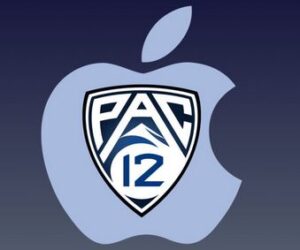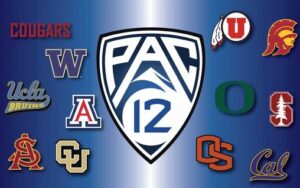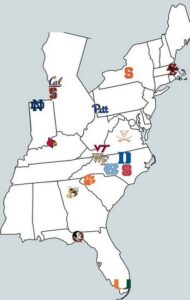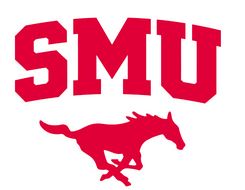Podcast: Play in new window | Download
Subscribe: RSS
As college sports fans try to determine the winners and losers in the latest round of college conference chess, the airline business should be very happy. As some conferences (Big Ten and Big 12) are literally expanding from coast to coast, additional flights are going to be needed to carry college sports teams to far-flung future destinations.
In case you haven’t noticed, major college athletic programs on the West Coast have been in full panic mode recently. For those teams, it’s all about money and remaining relevant within the American sports (and television) landscape.
My last story (prior to a brief vacation) about the destruction of the newly titled “Pack-Your-Bags 12” Conference has proven to be pretty doggone accurate. Score one for your ol’ Swami!

The long-awaited and much ballyhooed new Pac-12 Conference television deal was finally announced last week. The offer came with a guarantee of at least $20 million annually for each Pac-12 school. Though the value was reasonable, it was the name of the new TV partner which raised eyebrows.

For most Americans, Apple TV+ isn’t exactly your go-to television destination looking for college sports. The athletes want their games to be seen by as many people as possible, too.
This newly proposed Apple TV+ deal for the Pac-12 Conference was, pardon my pun, a rotten idea.

The online subscription service has more than 25 million worldwide subscribers. Adding the remaining Pac-12 Conference members to a long-term sports deal would help build more subscribers for Apple TV+. Most US college athletics fans are unlikely to pay an extra $6.99/month for the privilege of watching just West Coast sports.
The nine remaining Pac-12 Conference members yawned at the Apple TV+ deal. Five of them bolted for the Big Ten and Big 12 Conferences in the past week.
The Pac-12 Conference is effectively dead.

Which schools left the Pac-12 Conference and where did they go?
Before we cover the remaining four teams, it is wise to show the villains who have precipitated the demise of the Pac-12 Conference.

June, 2022 – USC and UCLA announced they were leaving for the Big Ten Conference in 2024
July, 2023 – Colorado advised they will join the Big 12 Conference in 2024
August 4, 2023 – Oregon and Washington proclaimed they will join the Big Ten in 2024
August 4, 2023 – Arizona, Arizona State, and Utah will transfer into the Big 12 in 2024
These teams will receive more money than if they accepted the proposed new television contract offer from Apple TV+. However, the additional travel requirements will be brutal for all of the college athletes involved as they will now travel from one end of the country to the other to play games.
What will happen to the four remaining Pac-12 schools?
Washington State – The Cougars are the least desirable of this group as the school is located in Pullman on the eastern side of the state. Washington State is much closer to Idaho than Seattle. The Spokane television market is only ranked #75.
Oregon State – The Beavers could be in a similar boat as Wazzou. Oregon State is located in Corvallis. It is about halfway between #22 US TV market Portland and #119 Eugene. With a current enrollment of 35,000 students, Oregon State brings a slightly better TV profile than Washington State.

Stanford – This private school has a rich academic tradition with an enrollment of only 16,000 students. Stanford is located in Palo Alto, California and is considered on the fringe of the #6 TV market for San Francisco/Oakland/San Jose. The Cardinal’s alumni group has collected an astounding $38 billion endowment to rank only behind Harvard and Yale.

California – Berkeley campus – Also located within the #6 San Francisco television market, public school Cal-Berkeley is generally not known for its prowess in sports. With nearly 50,000 students, this huge public university has a very large national alumni group.
Though the Mountain West Conference would welcome all four remaining schools, Stanford and California have been knocking on the door of the Atlantic Coast Conference this past week.
Yes, let’s talk about the ACC!

The ACC has now become a hot topic this week after the Pac-12’s demise.
Florida State University has long been one of the top TV draws in the conference. The Seminoles recently advised the ACC that they deserve a greater share of the conference television pie than less prominent members such as Boston College, Pitt, and Syracuse.

In a recent year, FSU claimed that that they appeared more times on television and, thus, produced 15% of the conference television revenues. Since the ACC splits its TV revenues equally across all schools, Florida State receives just 7% of the pie.
The ACC’s current television package with ESPN (through, gasp, 2036) pays each member institution around $25 million per year. The SEC and Big Ten schools will earn more than double that amount with their lucrative new television deals.
I think Florida State is making a valid point. If Florida State, Clemson, Miami, and Duke appear on ESPN the most, why shouldn’t they receive some type of financial bonus based on their annual performance?
Suppose the ACC were to pay 50% of the TV revenue as a baseline to each school. The other 50% of the television money could be allocated among the teams based on a formula (with football getting the highest weighting) involving the most TV appearances during the prior year.
In that manner, Florida State could (theoretically) have earned up to $30-35 million if the school has great football, basketball, and baseball teams in a season. Likewise, Boston College (which finished last in the ACC in football in 2022) would receive its baseline amount of $12.5 million plus a smaller appearance bonus. Let’s say BC wound up receiving “only” $15-20 million in the same season.
Right now, Florida State is willing to huff and puff and threaten to jump ship to either the SEC or the Big Ten. If they do, the current ACC rules would require the Seminoles to write a very large exit fee check estimated at a whopping $120 million!

This isn’t just about Florida State, either.
Other ACC members have started to whine about the allocation of TV money, too. Six other conference stalwarts (Virginia, Virginia Tech, North Carolina, North Carolina State, Clemson, and Miami of Florida) are contemplating legal measures trying to lower the ACC’s exorbitant exit fees and/or renegotiate the methodology of splitting the TV revenues.
The ACC has an August 15 deadline for any member school to notify that league if it wants to leave and change conferences prior to the 2024 season. Don’t look for it – this year.
Meanwhile…
Reports surfaced this week that Pac-12 (minus 8) Conference holdovers Stanford and Cal-Berkeley met with ACC representatives about possibly joining the conference. The good news for the other 14 ACC member schools is that any newly admitted teams will not be shrinking the current TV pie. Apparently, the ACC’s deal with ESPN would require the broadcaster to up the ante to give the new members the same dollar amount as current schools receive.
The more obvious question should be, “WHY would the ACC want either of those two West Coast teams?”

The ACC already has a rather lengthy 1,500 mile maximum travel distance between Boston College at the northern tip and Miami (FL) at the southern end of the league.
If the league expanded to add these two San Francisco teams, every conference school would need to fly about 3,000 miles to play games on the West Coast.

Only ESPN would care about the San Francisco television market. Making the ACC teams travel from coast to coast puts additional and unnecessary new stresses on the student athletes.
Perhaps the league might contemplate changing their name to the A&P Conference? (If you don’t get the joke, look it up).

Finally, what’s this rumor about SMU joining the ACC as well?
Southern Methodist University feels left out right now. The Dallas-based private school (enrollment of 13,000 students) is not happy that their I-45 rival University of Houston will begin playing football in the Big 12 Conference in just a few weeks. Dallas and Houston have their own Texas-sized rivalry in just about everything.
After years of being slighted by the Big 12, the Cougars finally received the call to move up after Texas and Oklahoma jumped to the SEC in 2024. That left Dallas-based SMU in the lesser-appreciated American Athletic Conference (AAC).

SMU’s wealthy alumni backers are not happy with being left behind. They want to play with the big boys, too.
If this sounds a bit familiar, it should.
SMU was the school which was given the NCAA’s infamous “Death Penalty” beginning in 1987 for numerous violations relating to overzealous boosters. The school eventually worked its way back into major college sports over the next decade.
For the ACC, the SMU Mustangs would bring the #5 ranked television market in Dallas-Fort Worth. With Dallas in the Central time zone, games against the ACC’s Eastern Time zone schools would not be a significant disruption. Air travel to Texas would cause extra costs for member schools but not nearly as much if the ACC added one or more of the former Pac-12 schools.

One report indicated that SMU would need to pay its current conference (AAC) a $10 million exit fee and provide 24 months of notice. The school seems to have an ample supply of donor cash to resolve any issues related to exiting the American Athletic Conference.
PREDICTIONS!

If (for some odd reason) the ACC decides to add two of the former Pac-12 schools (Stanford and Cal) by the end of next week, I fully expect that SMU will buy its way into the league, too. ESPN would grin from ear to ear. Adding the Dallas-Fort Worth TV market into the new A&P Conference would allow ESPN to charge an even higher advertising spot rate.
As for Florida State, the Seminoles have ALWAYS wanted to play in the SEC against their rival, University of Florida. I just can’t see FSU paying the ACC an exit fee of $120 million anytime soon. If the Seminoles (and several other ACC schools) can get the league to agree on a revised revenue sharing concept (similar to the one I proposed), Florida State wins.


Washington State and Oregon State should go ahead and plan a move into the Mountain West Conference beginning in 2024.

